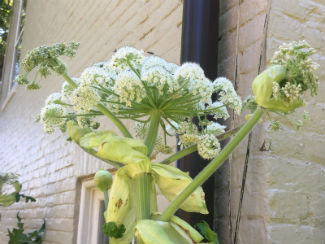
A patch of giant hogweed has been found in Clarke and Frederick counties. Statewide alerts have warned people to watch for this noxious, invasive plant that can cause painful blisters and even lead to severe eye injuries including blindness.
Jordan Metzgar, curator of the Massey Herbarium at Virginia Tech, and one of the researchers who helped identify the hogweed, said people shouldn’t worry. “For giant hogweed, I’d say the odds are you don’t have it. I’d probably be a lot more worried about other invasive plants that are not as toxic to people but would have more of an impact on your forestland or pastureland,” Metzgar noted.
Tree of heaven and garlic mustard plants all spread very quickly in woodlands, Metzgar explained. Other invasive plants include a tiny fern called giant salvinia that grows in warm, stagnant water. Purple loosestrife also colonizes wetlands and is easy to spot due to its purple flowers. “That one spreads really fast; it crowds out everything else quickly.”
While giant hogweed has been getting all the press, landowners face more challenges if they find one of the other invasive species on their property, Metzgar added.
“Control methods for some of these are well known and you can check online for management tips,” Metzgar shared. “A lot of them take a lot of hand labor to eradicate. Others you can take out with chemicals. It all depends on the species.”
While giant hogweed flowers resemble Queen Anne’s lace, Metzgar said it’s easy to determine if hogweed is growing on your land. Giant hogweed leaves are large and chunky, the blooms can be more than a foot wide, and the plants can grow up to 14 feet tall.
Previous outbreaks of giant hogweed in New York led to multi-million-dollar eradication campaigns and serious injuries to gardeners and landowners who didn’t take proper precautions.
Weed wacking and brush cutting “are the two worst things you can do,” Metzgar warned. Those actions spray sap and spread seeds from the hogweed.
If you suspect giant hogweed, take detailed photos and share them with a local Virginia Cooperative Extension specialist, a Master Gardener club or the Virginia Department of Agriculture and Consumer Services. If you attempt to eradicate the plant, completely cover your skin with protective clothing and wear gloves and eye protection, Metzgar advised.
“Wear sunscreen or do it after sunset. The chemicals in the sap that burn you are activated by sunlight. If you do get sap on your skin, wash immediately with soap and water and stay out of the sun for a few days,” Meztgar said.
He also suggested digging up the plants and drying them in a field or bagging and disposing of them.










